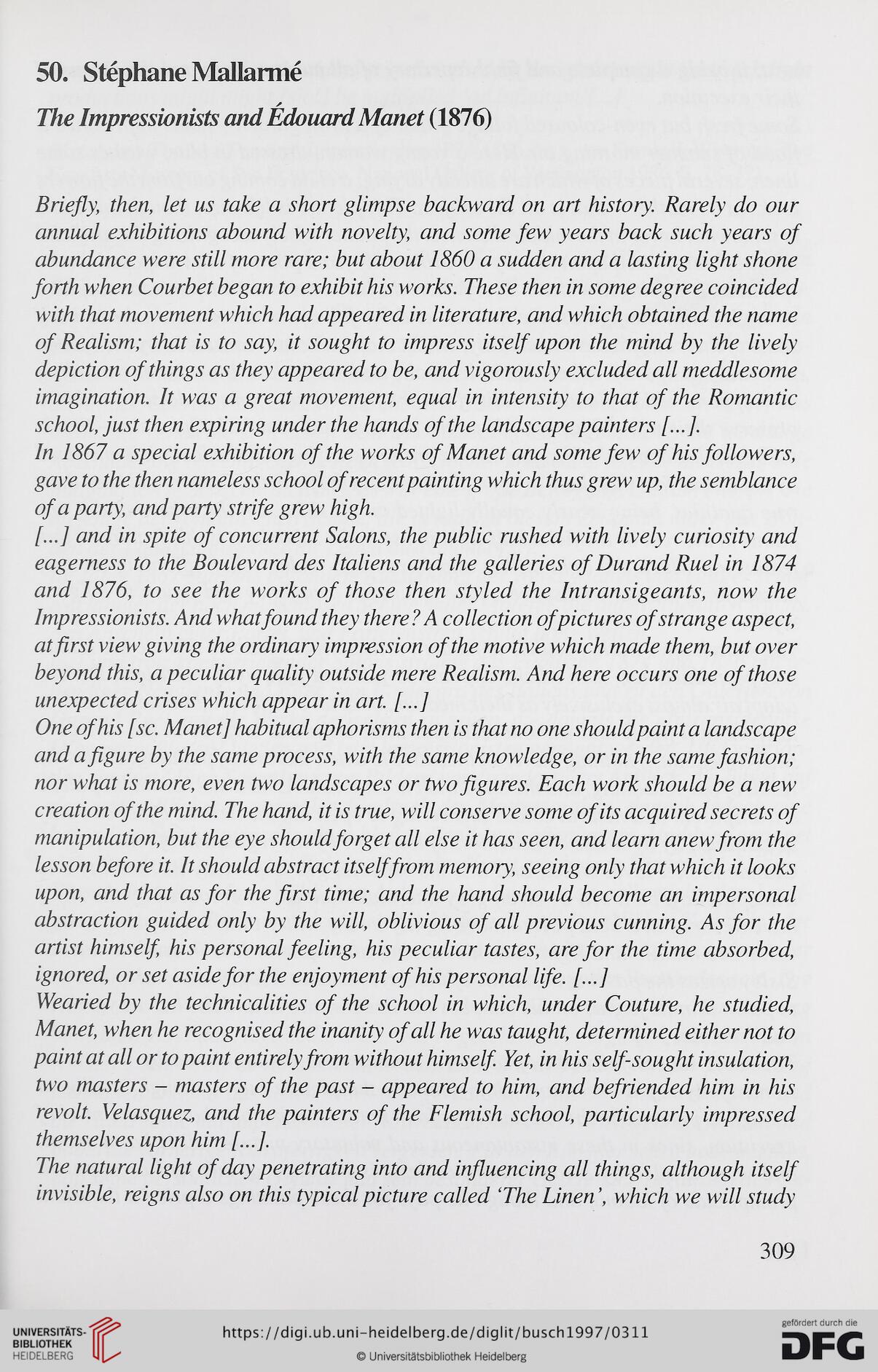50. Stephane Mallarme
The Impressionists and Edouard Manet (1876)
Briefly, then, let us take a short glimpse backward ort art history. Rarely do our
annual exhibitions abound with novelty, and some few years back such years of
abundance were still more rare; but about 1860 a sudden and a lasting light shone
forth when Courbet began to exhibithis works. These then in some degree coincided
with that movement which had appeared in literature, and which obtained the name
of Realism; that is to say it sought to impress itself upon the mind by the lively
depiction ofthings as they appeared to be, and vigorously excluded all meddlesome
imagination. It was a great movement, equal in intensity to that of the Romantic
school, just then expiring under the hands ofthe landscape painters [...].
In 1867 a special exhibition ofthe works of Manet and some few of his followers,
gave to the then nameless school ofrecentpainting which thus grew up, the semblance
ofa party, and party strife grew high.
[...] and in spite of concurrent Salons, the public rushed with lively curiosity and
eagemess to the Boulevard des Italiens and the galleries of Durand Ruel in 1874
and 1876, to see the works of those then styled the Intransigeants, now the
Impressionists. And whatfound they there ? A collection ofpictures of stränge aspect,
at first view giving the ordinary impr-ession ofthe motive which made them, but over
beyond this, a peculiar quality outside mere Realism. Arid here occurs one of those
unexpected crises which appear in art. [...]
One of his [sc. Manet] habitual aphorisms then is that no one shouldpaint a landscape
and a figure by the same process, with the same knowledge, or in the same fashion;
nor what is more, even two landscapes or two figures. Each work should be a new
creation of the mind. The hand, it is true, will conserve some ofits acquired secrets of
manipulation, but the eye shouldforget all eise it has seen, and learn anewfrom the
lesson before it. It should abstract itselffrom memory, seeing only that which it looks
upon, and that as for the first time; and the hand should beconie an impersonal
abstraction guided only by the will, oblivious of all previous cunning. As for the
artist himself, his personal feeling, his peculiar tastes, are for the time absorbed,
ignored, or set asidefor the enjoyment ofhispersonal life. [...]
Wearied by the technicalities of the school in which, under Couture, he studied,
Manet, when he recognised the inanity ofall he was taught, determined either not to
paint at all or to paint entirely from without himself. Yet, in his self-sought insulation,
two masters - masters of the past - appeared to him, and befriended him in his
revolt. Velasquez, and the painters of the Flemish school, particularly impressed
themselves upon him [...].
The natural light of day penetrating into and infiuencing all things, although itself
invisible, reigns also on this typical picture called ‘The Linen ’, which we will study
309
The Impressionists and Edouard Manet (1876)
Briefly, then, let us take a short glimpse backward ort art history. Rarely do our
annual exhibitions abound with novelty, and some few years back such years of
abundance were still more rare; but about 1860 a sudden and a lasting light shone
forth when Courbet began to exhibithis works. These then in some degree coincided
with that movement which had appeared in literature, and which obtained the name
of Realism; that is to say it sought to impress itself upon the mind by the lively
depiction ofthings as they appeared to be, and vigorously excluded all meddlesome
imagination. It was a great movement, equal in intensity to that of the Romantic
school, just then expiring under the hands ofthe landscape painters [...].
In 1867 a special exhibition ofthe works of Manet and some few of his followers,
gave to the then nameless school ofrecentpainting which thus grew up, the semblance
ofa party, and party strife grew high.
[...] and in spite of concurrent Salons, the public rushed with lively curiosity and
eagemess to the Boulevard des Italiens and the galleries of Durand Ruel in 1874
and 1876, to see the works of those then styled the Intransigeants, now the
Impressionists. And whatfound they there ? A collection ofpictures of stränge aspect,
at first view giving the ordinary impr-ession ofthe motive which made them, but over
beyond this, a peculiar quality outside mere Realism. Arid here occurs one of those
unexpected crises which appear in art. [...]
One of his [sc. Manet] habitual aphorisms then is that no one shouldpaint a landscape
and a figure by the same process, with the same knowledge, or in the same fashion;
nor what is more, even two landscapes or two figures. Each work should be a new
creation of the mind. The hand, it is true, will conserve some ofits acquired secrets of
manipulation, but the eye shouldforget all eise it has seen, and learn anewfrom the
lesson before it. It should abstract itselffrom memory, seeing only that which it looks
upon, and that as for the first time; and the hand should beconie an impersonal
abstraction guided only by the will, oblivious of all previous cunning. As for the
artist himself, his personal feeling, his peculiar tastes, are for the time absorbed,
ignored, or set asidefor the enjoyment ofhispersonal life. [...]
Wearied by the technicalities of the school in which, under Couture, he studied,
Manet, when he recognised the inanity ofall he was taught, determined either not to
paint at all or to paint entirely from without himself. Yet, in his self-sought insulation,
two masters - masters of the past - appeared to him, and befriended him in his
revolt. Velasquez, and the painters of the Flemish school, particularly impressed
themselves upon him [...].
The natural light of day penetrating into and infiuencing all things, although itself
invisible, reigns also on this typical picture called ‘The Linen ’, which we will study
309




